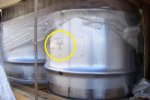Interesting... These were designed for the transportation of disassembled Russian nukes..
Information Bridge: DOE Scientific and Technical Information - Sponsored by OSTI
"AT-401R and AT-402R packagings. These packagings were designed
specifically for use by the Russians and will be used for shipment and
storage of their weapons components. The Defense Nuclear Agency is
purchasing 20,000 of these containers to provide to the Russians."
OAK RIDGE, Tenn., Sept. 28 /PRNewswire/ -- The Scientific Ecology Group, Inc., announced today that it has been awarded a contract valued at approximately $40 million to provide containers for dismantled Russian nuclear weapons components.
Under terms of the contract, funded under the Nunn-Lugar Act and awarded by the Defense Nuclear Agency (DNA), SEG will supply 32,968 containers over the next four years with the first containers to be supplied to the DNA in January 1994 for test and evaluation. The first shipment of containers to be produced are expected to arrive in Russia by the summer of 1994. DNA will then provide Russia the containers, spare parts and training necessary for their use and maintenance. The containers are being provided to Russia as part of the International agreement authorized by the "Nunn-Lugar" legislation to assist the former Soviet Union with the safe, secure dismantlement of their nuclear weapons.
H.W. Arrowsmith, president of SEG, said "the contract is significant both for SEG and the world. We are pleased to provide these containers to the DNA so that they can help Russia to expedite its dismantlement effort using proven, sound technology that will greatly reduce the potential for environmental contamination."
The containers SEG will supply were designed at the Department of Energy's Sandia National Laboratory in Albuquerque, N.M. Gregory Environmental Services, L. P., a limited partnership company owned by Gregory Enterprises and SEG, will assemble the containers at the Gregory Facility in Carlsbad, N. M., for the Department of Defense. It represents the second time container technology has been developed by Sandia and manufactured by SEG for the safe containment of hazardous and radioactive materials in support of the DOD.
The DNA is an agency of the United States Department of Defense. SEG is a unit of the Westinghouse Environmental Services Business Unit, a leading provider of services for the effective treatment and storage of a wide range of municipal, hazardous and radioactive wastes.
-0- 9/28/93
/CONTACT: H.W. Arrowsmith of SEG, 615-481-0222, or Vaughn Gilbert of Westinghouse, 412-642-5564/
(WX)
Fissile Material Containers
This program provides Russia with special containers designed by the Sandia National Laboratory to safely transport and store fissile material from approximately 25,000 dismantled Russian nuclear weapons.[1] The program stems from a June 1992 agreement between the United States and Russia entitled "Safe and Secure Transportation and Storage of Nuclear Weapons Materials Through the Provision of Fissile Material Containers."[2] In 1992 Sandia was contracted by the US Defense Special Weapons Agency to design and test containers for the program. The AT-400R containers they developed met the specified requirements of the DOE's Nuclear Explosive Safety Division, Russia's Ministry of Atomic Energy, and VNIIEF.[3] A contract to manufacture the containers was awarded to the Engineered Products Department (EPD) of the Westinghouse Corporation. This department was formerly the Scientific Ecology Group, Inc. of Carlsbad, New Mexico. Production of the containers began in October 1995. As required by the contract, the fissile material containers are produced and shipped to Russia at a rate of about 840 per month.[3] The United States shipped 10,000 of the AT-400R containers to Russia in 1996.[2] Approximately 14,000 additional containers were to have been shipped to Russia in 1997.[2] During the second quarter of FY 97, officials were to have determined if additional containers were needed.[1] Congress obligated nearly $50 million in Nunn-Lugar funds for this program through FY 1997.[4]





